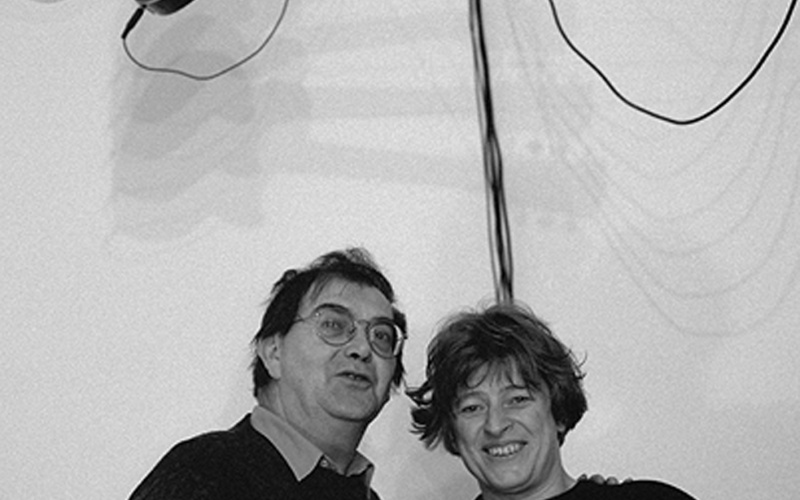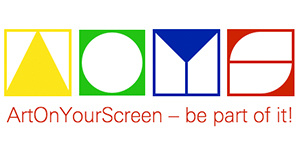Paul Panhuysen: Pattern Primer
»Pattern Primer« (1995/2014) by Paul Panhuysen is a critical analysis of the relationship between calculation and coincidence, order and disorder in the form of reactive software. With this tool the user is able generate an almost endless number of images based on similar elements. The Macromedia Director Program appeared in 1995 on the CD-ROM supplement of the English art journal »Artifice«. It draws on the artist’s painting works. Elementary geometric forms in his earlier works of painting are specifically permutated, such as in the series »Alea Iacta Sit« (1982). Throughout his career as an artist Panhuysen has repeatedly returned to questions relating to the perceptual complexity of structural order, such as in the work »Calcuco – Number Made Visible« (1999), of which there is an Internet version dating from 2002 in an appropriate Flash-format. Parallels may be seen in his works of sound art. His concert recording »Kanary Grand Band« (May 12, 1990, archived on »Sound Art @ Het Apollohuis«, ZKM milestones, Wergo WER 2069-2, 2011, CD 2, part 1) illustrate this. In one experimental arrangement with five bird cages and canary birds that can hear but not see one another, Panhuysen creates a circular interaction and sound space. He induces the birds to sing, processes the resulting sounds, feeds them back into the space and thus creates the drama of a composition of continuous feedback, of minimal, and continually cited but never identical sounds.
The full title of the work on CD is »Pattern Primer Number One«. This is drawn from a series. In keeping with the artist’s instructions, however, this version was retained. »Pattern« can be structure or model, scheme, example or template. »Primer« is not only grounding in painting, but also introduction, beginner’s textbook, or undercoat. The vocabulary of the title page is consciously chosen. Traces of educational and communicative semantics are both fruitful and necessary for understanding the works’ function as set against the biographical context of Paul Panhuysen (born 1934). Panhuysen himself taught and worked in museum education. Furthermore, with »Het Appolohuis« in Eindhoven he provided a home for sound all manner of experiments in the years between 1980 and 2001, wrote Rolf Sachsse in his accompanying text »Sound Art @ Het Apollohuis« (p.12). With respect to structure and function the work displayed an emphatically propaedeutic approach, a defining aspect in the choice of medium. During the 1990s, the CD ROM was considered an easy to handle, easily accessible means of distribution. In order to render the aesthetics of permutation more accessible to broader circles and to contemporaries, it seemed best suited as carrier. After having been reengineered for the Internet, this idea has thus been further augmented in the context of ArtOnYourScreen.
Once the program has been started, »Pattern Primer« displays four selection possibilities indicated by way of emoticons and set against a black surface. However, here, only two different program elements are operative. With the laughing emoticon, the receiver calls up the »fun« part, and via the serious emoticon, the »work« part. One click on the »fun« part guides the user to a square surface on which are stored five times five squares, each of which display either broad black strips on a white background or the same in an inverted arrangement. This then yields eight basic forms. Each of these squares can be activated with the mouse and shifted across the entire surface. By way of this procedure, the squares rotate, are supplied with color and generate cheerful, squeaking sounds reminiscent of imaginary electronic worlds. In view of this geometric division, which further extends the ideas of Concrete Art in the age of multimedia, one might expect that the shifted elements click into place so as to thus form an altered, but fixed arrangement in the sense of a different, though comparable image. This is not the case, however. With respect to this sense of expectation the user is, in fact, »only« in a position to generate disorder. The small inner squares randomly overlap one another in accordance with user action: a »free game«, indeed!
The »work« part contains three games modes. These maintain the general structure; namely, keep the 25 squares within the fixed grid of the overarching square. A vertical column of numbers can be seen to the bottom left. Much like a conveyor belt, each number from one to eight is highlighted by a small, red square. By clicking on one, all squares rotate on the games field in a new order. The software provides information with a text (click on the i-button below the large square), indicating that the tableau involves a magic square comprising eight basic forms. Each click on one of the numbers should, once again, result in a new magical square. There is also an option to change the screen’s background color. The visualization of an apparently endless number of possibilities, which still follow the strict arrangement of the magical square, is played through with a limited number of formal elements.
| Author: | Matthias Kampann |

